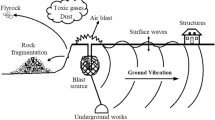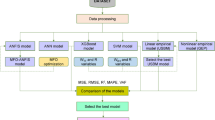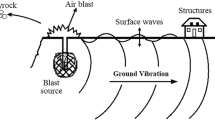Abstract
The primary purpose of this study was to develop a novel hybrid artificial intelligence model, with a robust performance, to predict ground vibration induced by bench blasting. An artificial neural network (ANN) was combined with the firefly algorithm (FFA), abbreviated as an FFA-ANN model, for this objective. To develop the FFA-ANN model, an ANN model (i.e., ANN 5-16-20-1) was established first; its weights and biases were then optimized by the FFA. A classification and regression tree (CART), a k-nearest neighbor (KNN), and a support vector machine (SVM) were also developed to confirm the power of the proposed FFA-ANN model. Eighty-three blasting events at a quarry mine in Vietnam were investigated to assess the danger of ground vibration through the developed models. The quality of the developed models was assessed through root-mean-squared error, mean absolute error, coefficient of correlation (R2), and variance account for. A simple ranking method and color gradient technique were also applied to evaluate the performance of the models. The results of this study indicated that the proposed FFA-ANN model was the most dominant model in comparison with other models (i.e., CART, SVM, KNN). The results also demonstrated that the FFA has a vital role in optimizing the ANN model in predicting blast-induced ground vibration.













Similar content being viewed by others
References
Abbas, A. S., & Asheghi, R. (2018). Optimized developed artificial neural network-based models to predict the blast-induced ground vibration. Innovative Infrastructure Solutions,3, 1–10.
Aldas, G., & Ecevitoglu, B. (2008). Waveform analysis in mitigation of blast-induced vibrations. Journal of Applied Geophysics,66(1–2), 25–30.
Al-Hunaidi, M. O., & Rainer, J. (1991). Remedial measures for traffic-induced vibrations at a residential site. I. Field tests. Canadian Acoustics,19(1), 3–13.
Aljarah, I., Faris, H., & Mirjalili, S. (2018). Optimizing connection weights in neural networks using the whale optimization algorithm. Soft Computing,22(1), 1–15.
Ambraseys, N. R., & Hendron, A. J. (1968). Dynamic behavior of rock masses. In K. G. Stagg & O. C. Zienkiewicz (Eds.), Rock mechanics in engineering practices (pp. 203–207). New York: Wiley.
Amiri, M., Amnieh, H. B., Hasanipanah, M., & Khanli, L. M. (2016). A new combination of artificial neural network and K-nearest neighbors models to predict blast-induced ground vibration and air-overpressure. Engineering with Computers,32(4), 631–644.
Arthur, C. K., Temeng, V. A., & Ziggah, Y. Y. (2019). Multivariate Adaptive Regression Splines (MARS) approach to blast-induced ground vibration prediction. International Journal of Mining, Reclamation and Environment. https://doi.org/10.1080/17480930.2019.1577940.
Barazzetti, L. (2018). Point cloud occlusion recovery with shallow feedforward neural networks. Advanced Engineering Informatics,38, 605–619.
Behzadafshar, K., Mohebbi, F., Soltani Tehrani, M., Hasanipanah, M., & Tabrizi, O. (2018). Predicting the ground vibration induced by mine blasting using imperialist competitive algorithm. Engineering Computations,35(4), 1774–1787.
Bui, D. T., Nhu, V.-H., & Hoang, N.-D. (2018). Prediction of soil compression coefficient for urban housing project using novel integration machine learning approach of swarm intelligence and multi-layer perceptron neural network. Advanced Engineering Informatics,38, 593–604.
Bui, X.-N., Moayedi, H., & Rashid, A. S. A. (2019a). Developing a predictive method based on optimized M5Rules–GA predicting heating load of an energy-efficient building system. Engineering with Computers. https://doi.org/10.1007/s00366-019-00739-8.
Bui, X.-N., Muazu, M. A., & Nguyen, H. (2019b). Optimizing Levenberg–Marquardt backpropagation technique in predicting factor of safety of slopes after two-dimensional OptumG2 analysis. Engineering with Computers. https://doi.org/10.1007/s00366-019-00741-0.
Bui, X. N., Nguyen, H., Le, H. A., Bui, H. B., & Do, N. H. (2019c). Prediction of blast-induced air over-pressure in open-pit mine: Assessment of different artificial intelligence techniques. Natural Resources Research. https://doi.org/10.1007/s11053-019-09461-0.
Chandar, K. R., Sastry, V., & Hegde, C. (2017). A critical comparison of regression models and artificial neural networks to predict ground vibrations. Geotechnical and Geological Engineering,35(2), 573–583.
Duvall, W. I., & Fogelson, D. E. (1962). Review of criteria for estimating damage to residences from blasting vibrations. US Department of the Interior, Bureau of Mines.
Duvall, W. I., & Petkof, B. (1958). Spherical propagation of explosion-generated strain pulses in rock. Bureau of Mines.
Ekanayake, S. D., Liyanapathirana, D., & Leo, C. J. (2014). Attenuation of ground vibrations using in-filled wave barriers. Soil Dynamics and Earthquake Engineering,67, 290–300.
Faradonbeh, R. S., & Monjezi, M. (2017). Prediction and minimization of blast-induced ground vibration using two robust meta-heuristic algorithms. Engineering with Computers,33(4), 835–851.
Fister, I., Fister, I., Jr., Yang, X.-S., & Brest, J. (2013). A comprehensive review of firefly algorithms. Swarm and Evolutionary Computation,13, 34–46.
Flood, I., Bewick, B. T., Dinan, R. J., & Salim, H. A. (2009). Modeling blast wave propagation using artificial neural network methods. Advanced Engineering Informatics,23(4), 418–423.
Folchi, R. (2003). Environmental impact statement for mining with explosives: a quantitative method. In Proceedings of the annual conference on explosives and blasting technique, 2003 (Vol. 2, pp. 285–296). ISEE; 1999.
Gao, W., Aslam, A., & Li, F. (2019). Effect of equivalence ratio on gas distribution and performance parameters in air-gasification of asphaltene: A model based on Artificial Neural Network (ANN). Petroleum Science and Technology,37(2), 202–207.
Gao, W., & Wang, W. (2018). Analysis of k-partite ranking algorithm in area under the receiver operating characteristic curve criterion. International Journal of Computer Mathematics,95(8), 1527–1547.
Ghasemi, E., Ataei, M., & Hashemolhosseini, H. (2013). Development of a fuzzy model for predicting ground vibration caused by rock blasting in surface mining. Journal of Vibration and Control,19(5), 755–770.
Günther, F., & Fritsch, S. (2010). neuralnet: Training of neural networks. The R Journal,2(1), 30–38.
Hajihassani, M., Armaghani, D. J., Marto, A., & Mohamad, E. T. (2015). Ground vibration prediction in quarry blasting through an artificial neural network optimized by imperialist competitive algorithm. Bulletin of Engineering Geology and the Environment,74(3), 873–886.
Hao, H., Wu, Y., Ma, G., & Zhou, Y. (2001). Characteristics of surface ground motions induced by blasts in jointed rock mass. Soil Dynamics and Earthquake Engineering,21(2), 85–98.
Hasanipanah, M., Monjezi, M., Shahnazar, A., Armaghani, D. J., & Farazmand, A. (2015). Feasibility of indirect determination of blast induced ground vibration based on support vector machine. Measurement,75, 289–297.
Hasanipanah, M., Naderi, R., Kashir, J., Noorani, S. A., & Qaleh, A. Z. A. (2017). Prediction of blast-produced ground vibration using particle swarm optimization. Engineering with Computers,33(2), 173–179.
Hiep, T. D. (2018). The technical report of Tan Dong Hiep quarry mines (in Vietnamese). (pp. 1–68). Binh Duong province
Holmberg, R. (1979) Design of tunnel perimeter blasthole patterns to prevent rock damage. In Proc. IMM Tunnelling’79 Conference, London (pp. 3–6).
Ibrahim, S., Choong, C. E., & El-Shafie, A. (2019). Sensitivity analysis of artificial neural networks for just-suspension speed prediction in solid-liquid mixing systems: Performance comparison of MLPNN and RBFNN. Advanced Engineering Informatics,39, 278–291.
Jaradat, A. S., & Hamad, S. B. (2018). Community structure detection using firefly algorithm. International Journal of Applied Metaheuristic Computing (IJAMC),9(4), 52–70.
Kahriman, A. (2004). Analysis of parameters of ground vibration produced from bench blasting at a limestone quarry. Soil Dynamics and Earthquake Engineering,24(11), 887–892.
Karthikeyan, S., Asokan, P., & Nickolas, S. (2014). A hybrid discrete firefly algorithm for multi-objective flexible job shop scheduling problem with limited resource constraints. The International Journal of Advanced Manufacturing Technology, 72(9), 1567–1579. https://doi.org/10.1007/s00170-014-5753-3.
Khandelwal, M., Kumar, D. L., & Yellishetty, M. (2011). Application of soft computing to predict blast-induced ground vibration. Engineering with Computers,27(2), 117–125.
Khandelwal, M., & Singh, T. (2006). Prediction of blast induced ground vibrations and frequency in opencast mine: a neural network approach. Journal of Sound and Vibration,289(4–5), 711–725.
Kuzu, C. (2008). The importance of site-specific characters in prediction models for blast-induced ground vibrations. Soil Dynamics and Earthquake Engineering,28(5), 405–414.
MacGlennon, G., Nilsson, P., & Casson, G. (2017). Assessing peak particle velocity PPV and air pressure disturbance from marine seismic operations–introducing a method for establishing coastal environmental safety distances. In SPE Abu Dhabi International Petroleum Exhibition & Conference, 2017. Society of Petroleum Engineers.
Mines, U. S. B., & Siskind, D. (1980). Structure response and damage produced by ground vibration from surface mine blasting. New York: US Department of the Interior, Bureau of Mines.
Moayedi, H., Moatamediyan, A., Nguyen, H., Bui, X.-N., Bui, D. T., & Rashid, A. S. A. (2019). Prediction of ultimate bearing capacity through various novel evolutionary and neural network models. Engineering with Computers. https://doi.org/10.1007/s00366-019-00723-2.
Monjezi, M., Ghafurikalajahi, M., & Bahrami, A. (2011). Prediction of blast-induced ground vibration using artificial neural networks. Tunnelling and Underground Space Technology,26(1), 46–50.
Monjezi, M., Hasanipanah, M., & Khandelwal, M. (2013). Evaluation and prediction of blast-induced ground vibration at Shur River Dam, Iran, by artificial neural network. Neural Computing and Applications,22(7–8), 1637–1643.
Murmu, S., Maheshwari, P., & Verma, H. K. (2018). Empirical and probabilistic analysis of blast-induced ground vibrations. International Journal of Rock Mechanics and Mining Sciences,103, 267–274.
Nateghi, R., Kiany, M., & Gholipouri, O. (2009). Control negative effects of blasting waves on concrete of the structures by analyzing of parameters of ground vibration. Tunnelling and Underground Space Technology,24(6), 608–616.
Nelson, J. T., & Saurenman, H. J. (1987). A prediction procedure for rail transportation groundborne noise and vibration. Transportation Research Record,1143, 26–35.
Nguyen, H., & Bui, X.-N. (2018). Predicting blast-induced air overpressure: A robust artificial intelligence system based on artificial neural networks and random forest. Natural Resources Research. https://doi.org/10.1007/s11053-018-9424-1.
Nguyen, H., Bui, X.-N., Bui, H.-B., & Cuong, D. T. (2019a). Developing an XGBoost model to predict blast-induced peak particle velocity in an open-pit mine: A case study. Acta Geophysica,67(2), 477–490. https://doi.org/10.1007/s11600-019-00268-4.
Nguyen, H., Bui, X.-N., Bui, H.-B., & Mai, N.-L. (2018). A comparative study of artificial neural networks in predicting blast-induced air-blast overpressure at Deo Nai open-pit coal mine, Vietnam. Neural Computing and Applications. https://doi.org/10.1007/s00521-018-3717-5.
Nguyen, H., Bui, X.-N., & Moayedi, H. (2019b). A comparison of advanced computational models and experimental techniques in predicting blast-induced ground vibration in open-pit coal mine. Acta Geophysica. https://doi.org/10.1007/s11600-019-00304-3.
Nguyen, H., Bui, X.-N., Tran, Q.-H., & Mai, N.-L. (2019c). A new soft computing model for estimating and controlling blast-produced ground vibration based on hierarchical K-means clustering and cubist algorithms. Applied Soft Computing,77, 376–386. https://doi.org/10.1016/j.asoc.2019.01.042.
Nguyen, H., Drebenstedt, C., Bui, X.-N., & Bui, D. T. (2019e). Prediction of blast-induced ground vibration in an open-pit mine by a novel hybrid model based on clustering and artificial neural network. Natural Resources Research. https://doi.org/10.1007/s11053-019-09470-z.
Nguyen, H., Moayedi, H., Foong, L. K., Al Najjar, H. A. H., Jusoh, W. A. W., Rashid, A. S. A., et al. (2019f). Optimizing ANN models with PSO for predicting short building seismic response. Engineering with Computers. https://doi.org/10.1007/s00366-019-00733-0.
Nguyen, H., Moayedi, H., Jusoh, W. A. W., & Sharifi, A. (2019g). Proposing a novel predictive technique using M5Rules-PSO model estimating cooling load in energy-efficient building system. Engineering with Computers. https://doi.org/10.1007/s00366-019-00735-y.
Olden, J. D., & Jackson, D. A. (2002). Illuminating the “black box”: A randomization approach for understanding variable contributions in artificial neural networks. Ecological Modelling,154(1–2), 135–150.
Olden, J. D., Joy, M. K., & Death, R. G. (2004). An accurate comparison of methods for quantifying variable importance in artificial neural networks using simulated data. Ecological Modelling,178(3–4), 389–397.
Rai, R., & Singh, T. (2004). A new predictor for ground vibration prediction and its comparison with other predictors. IJEMS, 11(3), 178–184.
Razmjooy, N., Khalilpour, M., & Ramezani, M. (2016). A new meta-heuristic optimization algorithm inspired by FIFA world cup competitions: theory and its application in PID designing for AVR system. Journal of Control, Automation and Electrical Systems,27(4), 419–440.
Reale, C., Gavin, K., Librić, L., & Jurić-Kaćunić, D. (2018). Automatic classification of fine-grained soils using CPT measurements and artificial neural networks. Advanced Engineering Informatics,36, 207–215.
Roy, P. P. (1991). Vibration control in an opencast mine based on improved blast vibration predictors. Mining Science and Technology,12(2), 157–165.
Saadat, M., Khandelwal, M., & Monjezi, M. (2014). An ANN-based approach to predict blast-induced ground vibration of Gol-E-Gohar iron ore mine. Iran. Journal of Rock Mechanics and Geotechnical Engineering,6(1), 67–76.
Sekhar, G. C., Sahu, R. K., Baliarsingh, A., & Panda, S. (2016). Load frequency control of power system under deregulated environment using optimal firefly algorithm. International Journal of Electrical Power & Energy Systems,74, 195–211.
Shayanfar, H., & Gharehchopogh, F. S. (2018). Farmland fertility: A new metaheuristic algorithm for solving continuous optimization problems. Applied Soft Computing,71, 728–746.
Singaravel, S., Suykens, J., & Geyer, P. (2018). Deep-learning neural-network architectures and methods: Using component-based models in building-design energy prediction. Advanced Engineering Informatics,38, 81–90.
Singh, M., Patel, R., & Neema, D. (2019). Robust tuning of excitation controller for stability enhancement using multi-objective metaheuristic Firefly algorithm. Swarm and Evolutionary Computation,44, 136–147.
Taheri, K., Hasanipanah, M., Golzar, S. B., & Majid, M. Z. A. (2017). A hybrid artificial bee colony algorithm-artificial neural network for forecasting the blast-produced ground vibration. Engineering with Computers,33(3), 689–700.
Torres, N., Reis, J. A., Luiz, P. L., Costa, J. H. R., & Chaves, L. S. (2019). Neural network applied to blasting vibration control near communities in a large-scale iron ore mine. In Proceedings of the 27th international symposium on mine planning and equipment selection - MPES 2018 (pp. 81–91). Cham: Springer.
Torres, V. N., Silveira, L. G., Lopes, P. F., & de Lima, H. M. (2018). Assessing and controlling of bench blasting-induced vibrations to minimize impacts to a neighboring community. Journal of Cleaner Production,187, 514–524.
Van Gerven, M., & Bohte, S. (2018). Artificial neural networks as models of neural information processing. Lausanne: Frontiers Media SA.
Venkatesh, H. (2005). Influence of total charge in a blast on the intensity of ground vibrations—field experiment and computer simulation. Fragblast,9(3), 127–138.
Verma, A., & Singh, T. (2013). Comparative study of cognitive systems for ground vibration measurements. Neural Computing and Applications,22(1), 341–350.
Villarrubia, G., De Paz, J. F., Chamoso, P., & De la Prieta, F. (2018). Artificial neural networks used in optimization problems. Neurocomputing,272, 10–16.
Walczak, S. (2019). Artificial neural networks. In Advanced methodologies and technologies in artificial intelligence, computer simulation, and human–computer interaction (pp. 40–53). IGI Global.
Wang, M., Shi, X., & Zhou, J. (2018a). Charge design scheme optimization for ring blasting based on the developed Scaled Heelan model. International Journal of Rock Mechanics and Mining Sciences,110, 199–209.
Wang, M., Shi, X., Zhou, J., & Qiu, X. (2018b). Multi-planar detection optimization algorithm for the interval charging structure of large-diameter longhole blasting design based on rock fragmentation aspects. Engineering Optimization,50(12), 2177–2191.
Xue, X. (2019). Neuro-fuzzy based approach for prediction of blast-induced ground vibration. Applied Acoustics,152, 73–78.
Yang, X.-S. (2009). Firefly algorithms for multimodal optimization. In International symposium on stochastic algorithms, 2009 (pp. 169–178). Springer.
Zhang, X., Nguyen, H., Bui, X.-N., Tran, Q.-H., Nguyen, D.-A., Bui, D. T., et al. (2019). Novel Soft Computing Model for Predicting Blast-Induced Ground Vibration in Open-Pit Mines Based on Particle Swarm Optimization and XGBoost. Natural Resources Research. https://doi.org/10.1007/s11053-019-09492-7.
Zhong, B., Xing, X., Love, P., Wang, X., & Luo, H. (2019). Convolutional neural network: Deep learning-based classification of building quality problems. Advanced Engineering Informatics,40, 46–57.
Zhou, Z., & Gong, J. (2018). Automated residential building detection from airborne LiDAR data with deep neural networks. Advanced Engineering Informatics,36, 229–241.
Zhou, J., Li, X., & Mitri, H. S. (2016a). Classification of rockburst in underground projects: comparison of ten supervised learning methods. Journal of Computing in Civil Engineering,30(5), 04016003.
Zhou, J., Li, X., & Shi, X. (2012). Long-term prediction model of rockburst in underground openings using heuristic algorithms and support vector machines. Safety Science,50(4), 629–644.
Zhou, J., Nekouie, A., Arslan, C. A., Pham, B. T., & Hasanipanah, M. (2019). Novel approach for forecasting the blast-induced AOp using a hybrid fuzzy system and firefly algorithm. Engineering with Computers. https://doi.org/10.1007/s00366-019-00725-0.
Zhou, J., Shi, X., & Li, X. (2016b). Utilizing gradient boosted machine for the prediction of damage to residential structures owing to blasting vibrations of open pit mining. Journal of Vibration and Control,22(19), 3986–3997.
Acknowledgments
The authors would like to thank Hanoi University of Mining and Geology (HUMG), Hanoi, Vietnam; Duy Tan University, Da Nang, Vietnam; the Center for Mining, Electro-Mechanical research of HUMG, and all the engineers as well as leaders of the Tan Dong Hiep quarry clustering who helped us with this project.
Author information
Authors and Affiliations
Corresponding authors
Rights and permissions
About this article
Cite this article
Shang, Y., Nguyen, H., Bui, XN. et al. A Novel Artificial Intelligence Approach to Predict Blast-Induced Ground Vibration in Open-Pit Mines Based on the Firefly Algorithm and Artificial Neural Network. Nat Resour Res 29, 723–737 (2020). https://doi.org/10.1007/s11053-019-09503-7
Received:
Accepted:
Published:
Issue Date:
DOI: https://doi.org/10.1007/s11053-019-09503-7




